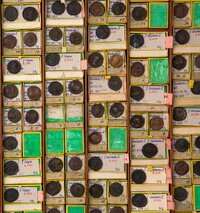Front: Auf der l. Schulter drapierte Büste (oder Büste mit Ägis) des Traianus mit Lorbeerkranz nach r.
Rear: Pax thronend nach l., in der ausgestreckten r. Hand ein Olivenzweig, den l. Unterarm auf die Thronlehne gestützt. L. vor Pax unter dem Olivenzweig ein kniender Daker nach r., mit bittflehend erhobenen Händen.
Chop mark: A mark of undefined form made normally with a chisel-like tool, for example to test the purity of the core of a coin. It can also be the result of damage caused when the object was found.
en









